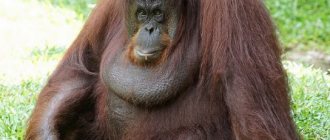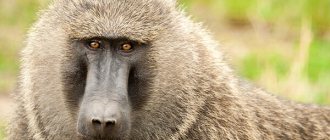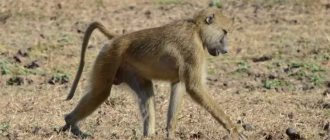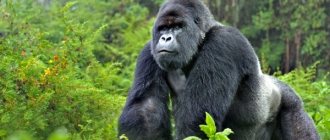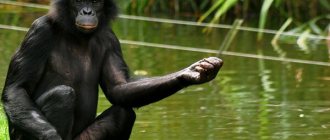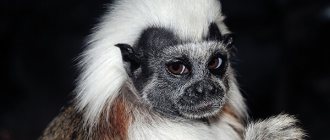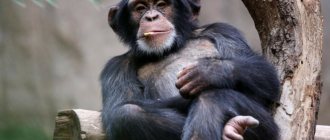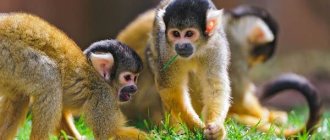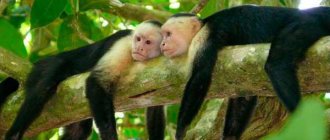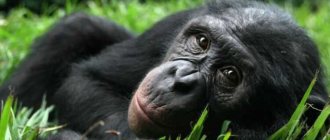Habitat
In nature, these animals live in the tropics. Two subspecies inhabit the islands of Sumatra and Borneo. Tropical rainforests with tall trees are their home. They jump from tree to tree using their long arms along branches and vines.
They can spend quite a lot of time in the treetops without descending to the ground. These creatures feel safer in the treetops than on the ground.
Character and lifestyle
The behavior of bonobos is radically different from the behavior of ordinary chimpanzees.
They do not hunt together, they do not sort things out using aggression and primitive war. Once in captivity, this animal can easily operate with various objects. They differ from all their other bonobo brothers in that in their family the main position is occupied not by males, but by females. Aggressive relations between males and females are almost completely absent; males have no complaints about adolescents and their small cubs. A male's status comes from the status of his mother.
Despite the fact that sexual contacts are paramount to them, the level of reproduction in their population is not high enough. Many scientists argue that bonobos are capable of altruism, compassion, and empathy. Kindness, patience and sensitivity are also not alien to them.
Sex plays the most important role in their lives. Therefore, there is practically no aggression in bonobo society. They rarely have monogamous relationships. Scientists suspect that gender and age do not matter to them in their sexual behavior. The only exception is a couple - a mother and an adult son. It is unacceptable for them to make love.
You can often notice different sexual desires between males of this monkey species. To communicate with each other, bonobos have special sound systems that primatologists are still trying to decipher. Their brains are well developed enough to be able to perceive other sound signals.
These animals try to avoid meeting people. Although there are times when they can appear in the fields and even in the village. But such proximity to humans is dangerous for bonobos. People hunt them for meat. And representatives of some nationalities of those settlements use their bones for various rituals.
Females always boldly protect their children from poachers, and they often die at their hands. Baby bonobos are always hunted. Poachers catch them and sell them to zoos for good money.
Bonobos love to repeat
But to a greater extent, the number of bonobos is sharply decreasing due to the fact that their habitats are being destroyed. A third of African bonobos are in great danger of destruction. Therefore, protests are taking place all over the world in favor of protecting these wonderful animals. These monkeys lead a half-terrestrial, half-arboreal lifestyle.
They spend most of their time on the ground. But very often they climb trees. They can be seen at high altitudes, about 50 meters. They drink with the help of a “sponge”. To do this, they have to chew several leaves, turning them into a sponge-like mass. After this, they soak the sponge with water and squeeze it into their mouth.
Bonobos can build themselves a simple tool from available materials. For example, in order to get termites and feast on them, a bonobo lowers a stick into their home, then takes it out along with the insects. In order to crack a nut, these animals come to the help of two stones.
They prefer to sleep in nests that they make with their own hands. Their favorite sleeping position is lying on their side with their knees bent. Sometimes they can sleep on their back with their legs pressed to their stomach.
Mother and baby bonobos take water baths
Bonobos love to take water baths during the hot season. They also get their food in the water. These monkeys do not know how to swim, so in order to stay on the water they lean on a stick and thus maintain balance. During water procedures, the bonobo mother has the child on her back.
Appearance
It’s not for nothing that we are genetically related. The orangutan monkey is very similar in appearance to the human body, but the body proportions are different. This monkey has long arms and short legs. Relying only on the lower limbs, the height of a male orangutan is about 140 cm, while the female is shorter - her height is about 110-115 cm. The average weight of a male is 80 kg, the weight of a female is 40-50 kg.
The fur of these animals is long, but not thick, and is bright red in color. There is no hair on the face, the skin is black, lighter around the eyes and nostrils. The facial part of the skeleton is wide, the forehead is wide, adult males have fatty growths on the cheeks, and there is a mustache and beard.
The jaws and teeth are massive; monkeys use them to easily crack nuts. Close-set eyes amaze with a “human” look, radiate calm and good nature. When looking at a photo of an orangutan, one gets the impression of a kind, non-aggressive creature.
Look - Capybaras: habitats, lifestyle and description of the rodent population. 110 photos and videos of main types
Note!
- Euthanasia of animals.
- Spitz. Features of the breed.
Car hammock for dogs. What it is?
The hands are similar to humans: there are no claws, instead there are nails on the fingers.
Natural enemies
Monkeys of many species are often captured and sold as pets, and large specimens are sent to laboratories at research institutes and industrial concerns.
The greatest threat to monkeys, along with other wild animals, is the active destruction of their natural habitats. For example, in China, the total number of langurs has sharply decreased, which was provoked by massive deforestation. It is for this reason that in 1975 the Chinese government banned langur hunting and established several special reserves.
The largest monkeys do not have any special natural enemies, but chimpanzees often die from the aggression of representatives of neighboring packs. Medium and small monkeys can become prey for wild cats, including leopard, jaguar, lion and tiger. Such primates are often hunted by many snakes, including pythons and boa constrictors, as well as crocodiles. In South America and the islands of the Philippine archipelago, monkeys can become prey for monkey-eating eagles, and in other habitats of primates they are attacked by hawks and kites, and crowned eagles.
Thus, today a large number of monkeys suffer from various types of natural enemies, as well as people who destroy four-armed mammals for the sake of obtaining delicious meat and expensive exotic fur. Farmers often shoot monkeys that destroy crops or crops. However, the greatest threat to many monkey species currently comes from capture for the exotic pet trade.
Behavior
These are peaceful representatives of primates. They are loners and practically do not live in groups. Sometimes the male maintains a "harem". The habitat is divided between individuals. There are almost never wars between them and very rarely fights.
If a stranger wanders into the male’s territory, then, as a rule, it does not lead to war. Males use a “psychic attack” - they create a lot of noise and screaming.
At the same time, they not only make various sounds and yell, but also break branches and shake trees until someone gives up first and leaves.
Diet of orangutans
Orangutan monkeys do not follow a strict vegetarian diet. They are not averse to eating bird eggs and little chicks. Cases of hunting of other primates – loris – have been recorded. In addition to a wide variety of fruits (they prefer bananas, mangoes, plums), the menu of forest people includes:
- tree bark;
- honey;
- nuts;
- leaves;
- insects.
In general, they have a rather slow metabolism and adults are able to go without food for several days.
Life cycle
In nature, the lifespan of an orangutan is approximately 30-40 years. Females reach sexual maturity at 8-12 years, males at 14-15 years. The female gives birth once every 3-4 years.
Classification
According to the results of recent research, there are three species of orangutans with three subspecies in one of them:
- Pongo pygmaeus - Kalimantan orangutan Subspecies Pongo pygmaeus pygmaeus
(lives in northwest Kalimantan) - Subspecies Pongo pygmaeus morio
(northeast of the island) - Subspecies Pongo pygmaeus wurmbii
(southwest of the island)
Previously, one species stood out: the common orangutan ( Pongo pygmaeus
) with the subspecies Kalimantan orangutan (
pygmaeus pygmaeus
) and Sumatran orangutan (
Pongo pygmaeus abelii
).
Reproduction
Most often, the female gives birth to one baby, rarely two. The baby spends the first year of life almost entirely on the mother's body. The mother feeds the babies with milk until they are 3-4 years old. The male does not take part in raising the babies.
Note!
- Removal and cremation of animals
- Cynologists - who are they?
Car soundproofing. What is she like?
The orangutan mother is an exemplary mother. She tenderly cares for the little orangutan. Until 3-4 years old, the baby orangutan even sleeps with her in the same nest in the tree. The mother carefully monitors the baby’s hygiene by licking him.
Until 5-8 years old, the cubs live with their mother, and then leave her and begin an independent life. These creatures, unlike most primates, do not live in packs.
Vocalization
Orangutans are quite silent. There are a number of squeak-like sounds that mother and calf use to communicate. The most famous is the so-called long call, which can be emitted by a sexually mature, self-confident male. This cry can be heard in the jungle at a distance of several kilometers. With such cries, animals notify of their presence, but these sounds do not carry any aggressive or sexual overtones. Diet and feeding behavior Orangutans eat fruits (durian, rambutan, jackfruit, lychee, mangosteen, mango, fig), young shoots of vines and trees along with bark. Bird eggs, small invertebrates and insects are sometimes found and eaten. These monkeys are very inventive and skilled in different ways of obtaining food from hard-to-reach places. There is also a noticeable difference in food preferences: Sumatran orangs eat more fruits and invertebrates, but less twig food than Bornean animals. Only Sumatran orangs know how to make tools for obtaining food.
Raising offspring
The male does not take part in raising the babies. Next to the cubs there is only the female. Sometimes females with cubs of the same male live in small groups. The animals play with each other. Kids interact with teenagers.
Mothers who monitor what is happening sometimes allow teenagers to hold their babies. Games with the male of grown-up babies occur exclusively on the initiative of small primates.
One Hundred Years of Solitude
Orangutans are the only anthropoids that lead a solitary lifestyle. Chimpanzees and bonobos have group marriages, gorillas have a harem, while male orangutans and females with their cubs live strictly separately and meet only when the female needs the next cub. And this happens infrequently - once every 6-7 years. This love of solitude is surprising, since high intelligence is usually combined with a complex social structure and developed relationships between group members. But studies of orangutans have shown that their groups collapsed quite recently, no more than a few hundred years ago, and this was probably due to a drop in forest productivity and anthropogenic pressure on the population. Moreover, in Sumatra, orangutans remained closer to the group format: the dominant male controls a large territory, which includes enclaves of several females with cubs. But the semblance of a marriage-pair is formed only during the breeding season.
Female Tutut, camp “Liki”
Moreover, orangutans have developed a technique for determining the character of the groom and his matrimonial suitability. “They approached the dining male and stole some delicacy from him, but did not run far, but remained to watch the reaction of the robbed. If he began to be indignant and showed aggression, demanding the return of food, the females ran away screaming. But if the male took the incident calmly, the female remained with him and in most cases, in the near future, became his sexual partner. By stealing food, sexually active females test the degree of aggressiveness of males,” reports the journal Behavioral Ecology and Sociobiology
.
The hypothesis of a recent loss of the group way of life is also supported by strong sexual dimorphism. In truly solitary animals, males and females are almost indistinguishable from each other. In orangutans, males are sometimes twice as large, more powerful and shaggy than females; their heads are decorated with a massive facial disc of skin and fat. Another unique feature of orangutans is the presence of two forms of males, dominants with a developed facial disc and subdominants without it. Females, of course, prefer darker males, and mate less willingly with those without growths. But whether the development of the facial disc depends on genes and whether this is a congenital or acquired trait is still unknown.
In addition to purely aesthetic value, the facial disc serves as a resonator for males, enhancing their hoots, roars, screams and a host of other sounds (the situation is approximately the same with owls - see “Around the World” No. 11, 2015). Orangutans have a very complex and varied vocal language that helps them communicate in the dense forest: further evidence of only recently lost sociality. The meanings of some “words” are intuitive to us, while others come as a surprise. For example, a smacking sound does not mean “come for a kiss,” but “get out of here, or you’ll get it.” And a mistake in translation can cost you dearly.
Adult male Nanang in the forest
Best articles: Learning to distinguish between Akita Inu and Shiba Inu
As is common among great apes, adolescents who have recently separated from their mother practice social skills by gathering in so-called gangs. We even saw one of these: five young orangutans sat sedately on neighboring trees, slowly and carefully eating leaves. No fights, no noise, nothing. Gang of nerds.
Orangutans have a couple of hundred types of fruits and edible plants on their menu, but most of all they love ripe durian (this “king of fruits” packed in a prickly skin with the taste of creme brulee and the smell of rotten baked onions drives not only orangutans crazy). It is believed that the droppings of orangutans that have eaten durian are one of the most stinking substances in the world. But this is the opinion of those who simply do not like orangutans and durians.
However, fruit abundance in the jungle is rare, and most of the year orangutans are content with the green parts of plants. Or they even live from hand to mouth, without experiencing any particular discomfort from this - their metabolic level is only slightly higher than that of sloths. Only females with cubs cannot afford to go hungry and, on occasion, even hunt slow lorises (small primates).
But when the fruit season comes in the jungle and there is no need to go to the feeding areas that the national park organizes for them, orangutans do not show themselves. And only our incredible luck can explain the fact that we still met quite a lot of them, about three dozen. They sat in the trees on both sides of the river, made nests, ate termites, nursed children, and we even shook hands with one red-haired beauty. And then they hit her lightly in the neck. Because every wild orangutan girl should be able to tell strangers off.
Life in captivity
In captivity, with good care, these animals live longer than in the wild - up to 60 years. At the same time, it is imperative that the monkeys are occupied with something. Their intelligence must be used. To do this, zoo workers come up with various activities and games for them.
At the same time, people have to be inventive so that primates do not get bored, since they quickly get bored with the same type of activities.
The most intelligent primates
Among captive primates, orangutans score the highest in intelligence tests. They have a good memory. It is not difficult to teach them to sit at the table, eat with a fork, or drink from a cup. The American scientist Hornaday, who studied the behavior and tool activity of monkeys, taught the orangutan to ride a bicycle, hammer nails, and unlock locks with keys.
Wild orangutans use their intelligence to create complex patterns to obtain food. Sometimes they invent some kind of device with which they can get to food that is inaccessible to other jungle inhabitants. So, in Sumatra they make something like devices for extracting seeds from large Nessia fruits, since these seeds are protected by a mass of spiny hairs. They also use special devices to extract honey from bee nests or to check tree holes for ants or termites.
Orangutans are great imitators, quickly learning from each other. Their predilection for imitating the behavior of others rather than inventing new behavior patterns leads to the emergence of local traditions. In different areas, red monkeys use different techniques for building nests, make different sounds, and manage food differently.
Endangered
The number of these creatures is extremely small. The number of individuals in captivity is only about 6 thousand. The main cause of extinction in the wild is deforestation in areas where the orangutan lives and poaching.
Poachers catch cubs for the purpose of selling, but at the same time they have to kill the female, since she will protect her cub to the last.
Every year the number of these animals decreases by 2%. If action is not taken, orangutans as a species will disappear from our planet in 10 years.
Evolution
The fossil record is incomplete, but scientists believe ancient hominoids diverged from the apes between 29 and 34 million years ago. The first modern hominoids appeared about 25 million years ago. Gibbons were the first group to diverge from other groups, about 18 million years ago, followed by the lineage of orangutans (about 14 million years ago), and gorillas (about 7 million years ago). The most recent split occurred between humans and chimpanzees about 5 million years ago. The closest living relatives of hominoids are the Old World monkeys, or marmosets.
